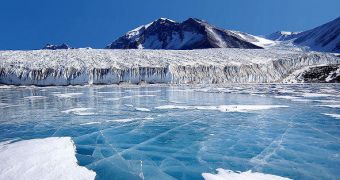Our planet's South Pole is arguably one of the most mysterious places there are. The exploration of the area is still in its infancy, and every new study brings to light remarkable finds, such as microbes living under miles of ice, at freezing temperatures, and with almost inexistent food sources. A deeper understanding of the factors that aided these organisms in evolving to adapt to such conditions could increase our knowledge of the world in general. Additionally, deep drills also provide windows into the past of our planet's climate, something that we seem to have desperately needed as of late.
The United States National Science Foundation (NSF) is currently providing $10 million in stimulus money to a research initiative that features experts from nine research institutions, which plans to drill miles under the West Antarctic Ice Sheet and the Ross Ice Shelf. The goal is to reach the underground lake that is found there, and also to penetrate inside a cavity that is believed to exist under the ice crust. The study will most likely lead to the discovery of new species that have not changed significantly for millions of years, since they have been trapped at that location by advancing glaciers.
“We expect to find novel microbial species and ecosystems in the subglacial hydrological system beneath the Whillans Ice Stream that thrive in permanent cold and darkness. Our recent work supports the notion that Antarctic subglacial environments are a habitat for life. The WISSARD project will allow us to study these systems in an unprecedented way,” the principal investigator of the GBASE (GeomicroBiology of Antarctic Subglacial Environments) program, Brent Christner, explains. He is also an assistant professor of biological sciences at the Louisiana State University (LSU).
The entire initiative has been dubbed the Whillans Ice Stream Subglacial Access Research Drilling (WISSARD) project. It also includes two other components in addition to GBASE, the Lake and Ice Stream Subglacial Access Research Drilling (LISSARD), and the Robotics Access to Grounding-zones for Exploration and Science (RAGES). “This is the largest and most exciting project I've ever been a part of. Subglacial exploration will be at the forefront of polar research in the future, and I'm confident that the years to follow will prove to be a very interesting time of discovery,” Christner says.
“To ensure that surface microbes and chemicals are not introduced during sampling, we will spend the next year rigorously testing the procedures and equipment that will be used to drill into and access these pristine subglacial environments. A special hot water drill is currently being built that will use heat, filtration and an ultraviolet treatment to sterilize the water that will be used to drill to the base of the ice sheet and prevent contamination,” the expert concludes.

 14 DAY TRIAL //
14 DAY TRIAL //